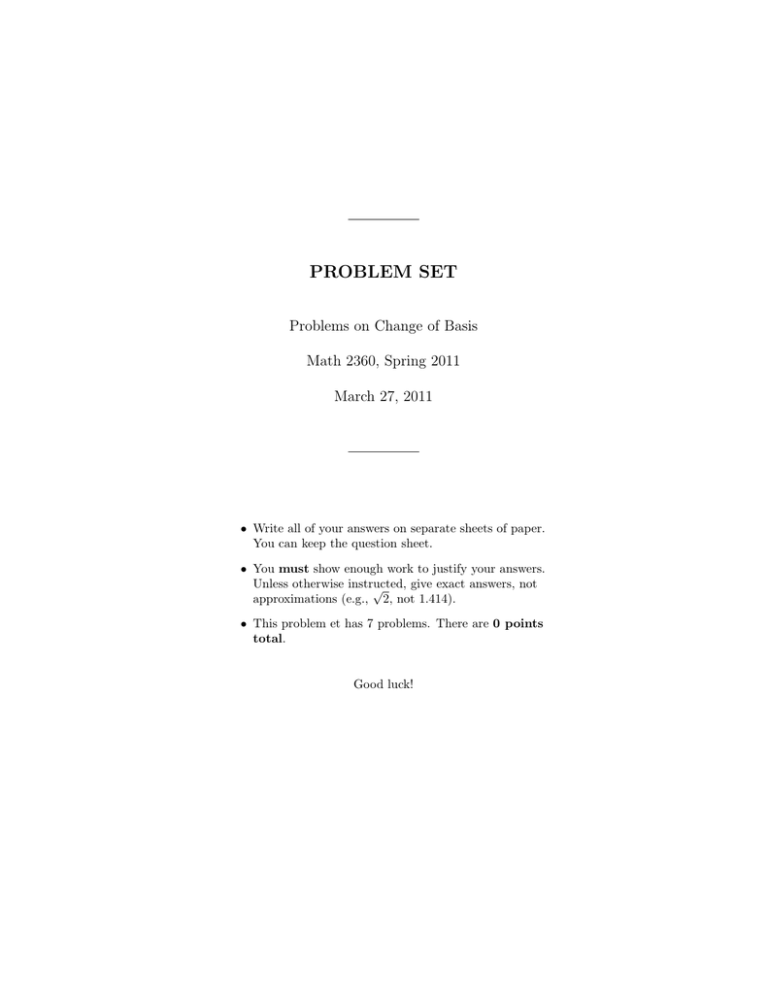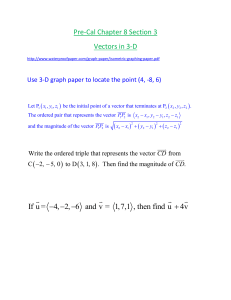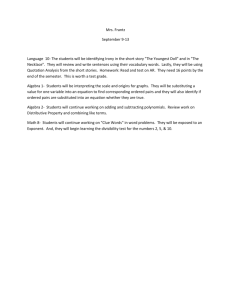PROBLEM SET Problems on Change of Basis Math 2360, Spring 2011
advertisement

PROBLEM SET
Problems on Change of Basis
Math 2360, Spring 2011
March 27, 2011
• Write all of your answers on separate sheets of paper.
You can keep the question sheet.
• You must show enough work to justify your answers.
Unless otherwise instructed,
give exact answers, not
√
approximations (e.g., 2, not 1.414).
• This problem et has 7 problems. There are 0 points
total.
Good luck!
Problem 1. Recall that
P3 = {a2 x2 + a1 x + a0 | a0 , a1 , a2 ∈ R}
is the space of polynomials of degree less than 3 and that
P = x2 x 1
is an ordered basis of P3 .
In each part you are given a row U of vectors in P3 . Find a matrix A so that
U = PA and determine if U is an ordered basis of P3 .
A.
U=
6 x2 + x + 5
12 x2 + 2 x + 10
5 x2 + x + 4
B.
U=
11 x2 + 15 x + 5
6 x2 + 10 x + 3
2 x2 + 3 x + 1
.
Problem 2. Recall that
P = x2
x
1
is an ordered basis of P3 .
Consider the following polynomials in P3 .
p1 (x) = 2x2 − x + 3,
p2 (x) = x2 − 1,
p3 (x) = 3x2 − 2x + 2.
Let Q be the row of vectors in P3 given by
Q = p1 (x) p2 (x) p3 (x) .
A. Show that Q is an ordered basis of P3 . Find the change of basis matrix
SPQ .
B. Find the change of basis matrix SQP .
C. Express x2 , x and 1 as linear combinations of the basis vectors in Q
D. Let q(x) = −x2 + 2x − 5. Find the [q(x)]Q . Express q(x) as a linear
combination of the vectors in Q.
E. Suppose that
−3
[g(x)]Q = 2 .
5
Find [g(x)]P and express g(x) as a linear combinations of P and Q
1
Problem 3. Recall that
P = x2
is an ordered basis of P3 .
Another ordered basis for P3 is
Q = 2x2 − x + 3
1
x
x2 − 1
3x2 − 2x + 2
Let T : P3 → P3 be the linear transformation defined by
T (p(x)) = p0 (x) + 2p(x).
If it’s not obvious to you that this is linear, check it.
A. Find the matrix of T with respect to the basis P, i.e., find [T ]PP .
B. Find the matrix of T with respect to the basis Q, i.e., find [T ]QQ .
T
C. Let g(x) be the element of P3 with [g(x)]Q = −2 1 3 . Find [T (g(x))]Q .
Write g(x) and T (g(x)) as linear combinations of Q.
Problem 4. Let
U = u1
where
u1 =
2
,
1
u2
u2 =
3
.
1
Then U is a basis of R2 (why?). Recall that
E = e1 e2
is the standard basis of R2 , where
1
e1 =
,
0
e2 =
0
.
1
A Find the change of basis matrices SEU and SU E .
B Let v be the vector
3
v=
.
−5
Find [v]E and [v]U . Express v as a linear combination of u1 and u2 .
2
To express v as a linear combination of U, we have
v = U[v]U
−18
= u1 u2
13
= −18u1 + 13u2
2
3
= −18
+ 13
.
1
1
we invite the reader to do the simplification to see if this is correct.
Problem 5. Let
U = u1
where
2
u1 =
,
1
u2
3
u2 =
.
1
is a basis of R2 . The row of vectors
W = w1
where
w1 =
5
,
2
w2 ,
w2 =
2
1
is also an ordered basis of R2 (why?).
Let v ∈ R2 be the vector such that [v]U = 2
T
−1 .
A. Find the change of basis matrices SU W and SWU .
B. Express v as a linear combination of U.
C. Find v as an element of R2 , equivalently, find v = [v]E .
You should check this by comparing with the previous part of the problem.
D. Find [v]W . Express v as a linear combination of W.
Problem 6. Let
U = u1
where
2
u1 =
,
1
u2
3
u2 =
.
1
Then U is a basis of R2 .
3
Let T : R2 → R2 be the transformation defined by
x1
2x1 + 3x2
T
=
.
x2
x1 − x2
A. Find the matrix of T with respect to the standard basis, i.e., find [T ]EE .
Another way to say it is that we’re looking for the matrix A so that T (x) =
Ax
B. Find the matrix of T with respect to the basis U.
C. Let v be the vector such that
[v]U =
−2
5
Find [T (v)]U . Express v and T (v) as linear combinations of U.
Problem 7. Let
U = u1
where
2
u1 =
,
1
u2
3
u2 =
.
1
Then U is a basis of R2 .
Suppose that T : R2 → R2 is the linear transformation such that
T (u1 ) = u1 + u2
T (u2 ) = 2u1 − u2 .
A. Find the matrix of T with respect to the basis U, i.e., find [T ]U U .
B. Find the matrix of T with respect to the standard basis E, i.e., find [T ]EE .
C. If v is the vector in R2 given by
v=
find T (v).
4
3
,
−5




